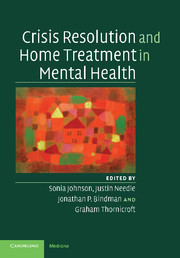Book contents
- Frontmatter
- Contents
- List of contributors
- Foreword
- Acknowledgements
- Section 1 Introduction and concepts
- Section 2 The evidence
- Section 3 Current practice
- 6 Crisis resolution teams: rationale and core model
- 7 The crisis resolution team within the community service system
- 8 Assessment of crises
- 9 Assessment and management of risk
- 10 Symptom management
- 11 Practical psychosocial interventions
- 12 Working with families and social networks
- 13 Strategies for promoting engagement and treatment adherence
- 14 Mixed blessings: service user experience of crisis teams
- 15 Early discharge and joint working between crisis teams and hospital services
- 16 Working with repeat users of crisis resolution services
- 17 Responding to diversity in home treatment
- 18 Coercion and compulsion in crisis resolution teams
- Section 4 Variations and enhancements
- Section 5 Developing a local service
- Index
- References
14 - Mixed blessings: service user experience of crisis teams
from Section 3 - Current practice
Published online by Cambridge University Press: 13 August 2009
- Frontmatter
- Contents
- List of contributors
- Foreword
- Acknowledgements
- Section 1 Introduction and concepts
- Section 2 The evidence
- Section 3 Current practice
- 6 Crisis resolution teams: rationale and core model
- 7 The crisis resolution team within the community service system
- 8 Assessment of crises
- 9 Assessment and management of risk
- 10 Symptom management
- 11 Practical psychosocial interventions
- 12 Working with families and social networks
- 13 Strategies for promoting engagement and treatment adherence
- 14 Mixed blessings: service user experience of crisis teams
- 15 Early discharge and joint working between crisis teams and hospital services
- 16 Working with repeat users of crisis resolution services
- 17 Responding to diversity in home treatment
- 18 Coercion and compulsion in crisis resolution teams
- Section 4 Variations and enhancements
- Section 5 Developing a local service
- Index
- References
Summary
An argument often made for crisis resolution teams (CRTs) is that they are likely to be more acceptable to service users and to carers than hospital admission. The unpopularity of inpatient wards makes this a very important possibility, but as yet the literature on CRTs contains little exploration of the extent to which they fit with the views of service users about what helps them in crises. In this chapter, two people who have used CRTs as well as other forms of acute care discuss how far they fit with what we know so far about service user views and give their own accounts of using these services and of their potential advantages and pitfalls.
Introduction
Service users have been calling for alternatives to hospital admission in a crisis for many years. Indeed, it has been one of the key campaigning issues for the user/survivor movement in the UK. A review of over 40 reports and studies about service user views of services, prepared for the Audit Commission's (1994) report Finding a Place, revealed consistently strong support for community-based crisis services offering a 24-hour response and aiming to prevent hospital admission. One of the demands in the Charter of Needs and Demands (Survivors Speak Out, 1987) agreed at one of the first ever service user conferences – the Edale conference held in 1987 – was for the ‘provision of refuge, planned and under the control of survivors of psychiatry’.
- Type
- Chapter
- Information
- Crisis Resolution and Home Treatment in Mental Health , pp. 177 - 186Publisher: Cambridge University PressPrint publication year: 2008



